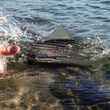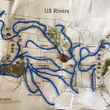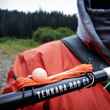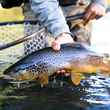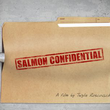As a parent, you want your kids to grow up to the best people they can be. You hope to provide them with enough of what they need to be happy and successful however one defines that term. The trouble is, there's no scorecard. You never really know how things are going and you just trust that they'll sort themselves out in a fashion. It's terribly nerve wracking stuff.
One of the things you try to resist is turning them into copies of yourself. It's tough. While it seems you share enough genetic material to preordain a path, you quickly find that the little buggers are infected by free will. Regardless of your desires, it all conspires to foil any efforts at duplication.
Sam and I have been fly fishing together for a few years. We started with guides, him in the front seat getting instruction, me in the back proudly watching, casting, smoking a cigar, snoozing. A few times a year we'd hit a small stream near the house. It was close enough that if the fishing was slow or we were inclined to do something else we hadn't wasted a whole lot of time in the car. Last year, the first of his teenage years, it could have been a moment when he zigged away from the water. Instead, he zagged. Our trips to small streams were replaced by more frequent trips to bigger water.



